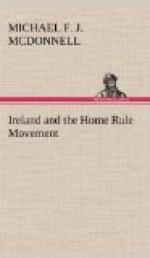Emigration was at one time a well-recognised remedy with English statesmen for Irish ills. Did not Michael Davitt once say that manacles and Manitoba were the two cures for Ireland which they could propose? Even then, no attempt was made to regulate emigration by the State. The ball which was thus set rolling at that date has been in motion ever since, and that which half a century ago was regarded as the hand of the deus ex machina setting right a grave economic problem has continued, so that it has become at this day a problem no less grave, which to an equal degree presses for solution.
Four million people in the last sixty-five years fled from the country, and though the figures, as they are published, seem to show a slight decrease each year, the apparent diminution is to a large extent fallacious, since the residue of population from which emigrants are drawn becomes each year less, and an apparent decrease may in truth be a relative increase.
We heard much a few years ago in England of the evils of immigration into the British Isles of aliens, whom the Board of Trade returns show amount to eight thousand per annum—a figure which appears paltry when compared with the forty thousand people who leave Ireland every year. It is a cry which one is told should make the thirty-seven million inhabitants of England and Scotland burn with indignation that this number of foreigners land on their shores every year. Surely we Irishmen have a far greater cause of complaint in the fact that out of a population of four and a half millions, less than is that of London, a number greater than those of a town of the size of Limerick emigrate every year. Most of these emigrants are in the prime of life. Their average age is from twenty to twenty-five, and more than ninety per cent. are between the ages of ten and forty-five years. Here is the crucial fact, that it is the young, the active, and the plucky who are being tempted by promises of success abroad, to which they see no likelihood of attaining at home, and in this way is established a system of the survival of the unfittest, an artificial selection of the most malignant kind, which is leaving the old, the infirm, the poor, and the unadventurous behind to swell the figures of pauperism and to propagate the race. All the authorities are agreed in attributing to this cause the lamentable increase of lunacy, which is one of the most terrible factors in the economy of modern Ireland. The last Census report shows the total number of lunatics and idiots to have been in 1851 equal to a ratio of 1 in 637 of the population, and to be in 1901 equal to a ratio of 1 in 178. The proportion is, as one would expect, highest in the purely agricultural districts and lowest in the neighbourhood of cities, such as Dublin and Belfast, where industrial conditions imply better wages and food, and a less monotonous existence.
It should be remembered that the proportion of imbeciles in Great Britain has risen in the period of fifty years as it has in Ireland—partly, no doubt, owing to a better system of registration of lunacy—but, at the same time, the fact remains that the average in Ireland is very much greater than in England and Wales, rising in some Irish counties to a proportion twice, and in another to a ratio thrice, as high as that of the average of the whole of England and Wales.




